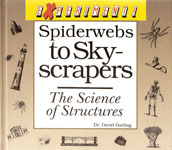SPIDERWEBS TO SKYSCRAPERS: The Science of Structures - 5. Buildings for Tomorrow
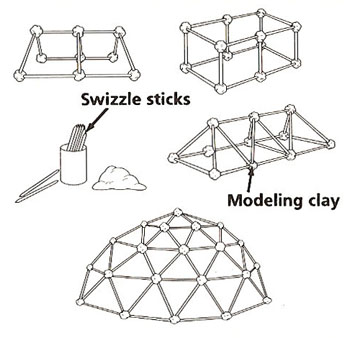
Figure 1. Model structures.
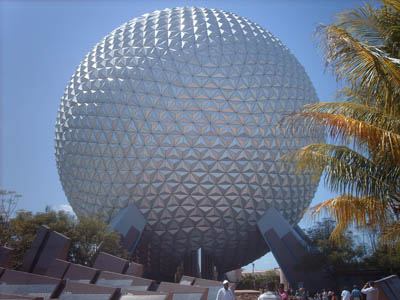
Figure 2. The Geosphere at Epcot in Florida is an example of a geodesic dome.
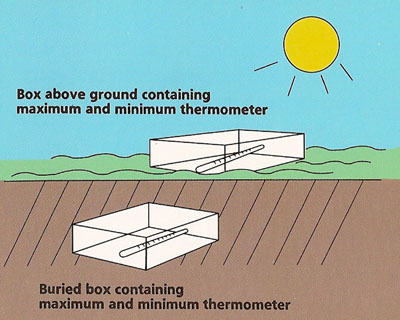
Figure 3. Earth shelter experiment.
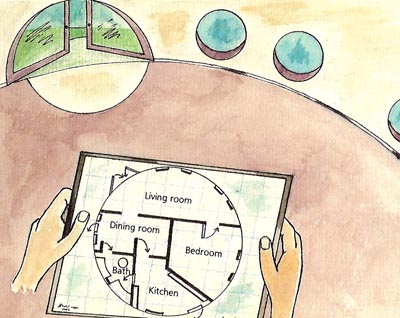
Figure 4. Designing your own home.
How will humans be living fifty years from now? Five miles up in soaring skyscraper cities? Or perhaps in homes underground? One thing seems certain: the buildings and communities in which people spend much of their lives will be very different in years to come than they are today.
Our current supplies of fuels are gradually running out, while at the same time the earth's population is rising steeply. This will mean that buildings in the next century will have to be much more energy efficient. They will need to be easier and cheaper to build, and be able to use energy sources, such as heat from the sun, which will not run out.

Super StructuresYou will need:
What to do:
Break off small pieces of clay, roll them into balls, and use these to hold together the swizzle sticks in various arrangements. Try building a dome-shaped structure such as the one shown here from a series of interlocking triangles (see Figure 2). Test this structure by pressing down on it. Is it strong? If so, can you explain why? |
Geodesic Domes
Not all buildings in which people live, work, or play need to have supporting walls inside. A dome-shaped structure will support itself because of the way the weight of the building is gradually directed down the curving sides of the building to the ground. However, a round dome is difficult to make. Much easier to assemble is a dome, known as a geodesic dome, constructed from flat triangular panels which fit perfectly together (see Figure 2).
"Geodesic" comes from two Greek words meaning "earth dividing." In the geodesic dome, a half-sphere is divided into a number of interlocking triangles – the more triangles used, the stronger the structure. All the sides of these triangles, usually made of steel, work together to carry the load evenly.
Geodesic domes are simple to build, strong and lightweight, and can be used for everything from tents to sports stadiums. Because they have no internal walls, the domes allow air to circulate freely around, making them easy to keep at a steady, comfortable temperature throughout.
The famous American architect Buckminster Fuller even suggested that entire cities might someday be enclosed within giant geodesic domes. Since no beams are needed to support them, such domes could be almost any size. Protected by a clear bubble of plastic, the city's inhabitants would never have to suffer from bad weather. On hot summer days, the dome's panels could be darkened to shield the city from the sun's glare. Such domes might be especially useful to protect future human colonies on other planets or the moon.

Earth SheltersYou will need:
What to do:
Do this experiment in summer when it is warm outside and the ground is dry.
Reset the thermometers using the magnet and place one thermometer in each of the shoe boxes. Early in the morning, put one of the boxes in a hole in the ground and cover it with about 6" of earth. Put the other box on top of the ground a few feet away from the buried box (see Figure 3). The next morning, open both boxes and make a note of the highest and lowest temperatures recorded by the thermometers. What are your results? Can you explain them?
Taking it further:
Repeat the experiment at different times of the year. Try placing the buried box at a variety of depths. Does this affect the range of temperatures you record? Are the results different if you bury the box in sand instead of soil? |
Building Underground
Underground or "earth-sheltered" buildings are becoming increasingly popular. They take advantage of the fact that soil does not let heat pass through it very easily. In fact, nine feet below the surface the temperature stays between 50°F and 68°F whatever the weather. Since very little heat can pass through its walls, an underground home is easy to keep warm in winter and remain comfortably cool even on the hottest summer day.
Often, the shell of an underground structure is made from precast sections of reinforced concrete. These are strong enough to withstand the weight of a large amount of overlying earth and the sideways pressure of soil on the walls.

Design a HomeYou will need:
What to do:
Your goal is to design and build a model of a house of the future. Decide on the type of home. Where will it be built – in a city, in the country, on a mountainside, in a desert, by the seashore? How many people will it accommodate? How will it be heated or cooled?
Sketch plans of the rooms. Is there easy access from one room to the next? Are the rooms a good size and shape for their purpose? How will the building be supported? What materials will you use?
Decide on the position of doors, windows, stairs, and other important features. Will your house be easy to keep at a comfortable temperature in both the winter and summer? Will it have enough natural light during the day? (see Figure 4)
When you have made detailed plans and sketches, try to make a model of the house using materials such as cardboard, balsa wood, and plastic.
Taking it further:
You might get ideas for your model by looking in magazines about houses or books on energy-efficient homes. Look more closely at the houses in your neighborhood. Try to combine the best features, plus some of your own, in your design.
This project would be suitable for, say, a science fair or a school competition. Working alone or in groups, entrants could display their results in the form of plans, artwork, and models, and be available to answer questions about their designs.
As well as homes, the project might involve, for example, plans for
a new library, school sports center, or shopping mall. A local architect
might be invited to act as judge and prizes be given to the winners
in various age categories. |

